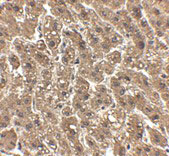erbB-2 Antibody
- SPECIFICATION
- CITATIONS
- PROTOCOLS
- BACKGROUND

Application
| WB, IHC-P, IF, E, IP |
|---|---|
| Primary Accession | P04626 |
| Other Accession | NP_004439, 54792096 |
| Reactivity | Human, Mouse, Rat |
| Host | Chicken |
| Clonality | Polyclonal |
| Isotype | IgY |
| Calculated MW | 137910 Da |
| Application Notes | erbB-2 antibody can be used for detection of erbB-2 by Western blot at 1 - 2 µg/mL. Antibody can also be used for immunohistochemistry starting at 2.5 µg/mL. For immunofluorescence start at 20 µg/mL. |
| Gene ID | 2064 |
|---|---|
| Target/Specificity | ERBB2; |
| Reconstitution & Storage | erbB-2 antibody can be stored at 4℃ for three months and -20℃, stable for up to one year. As with all antibodies care should be taken to avoid repeated freeze thaw cycles. Antibodies should not be exposed to prolonged high temperatures. |
| Precautions | erbB-2 Antibody is for research use only and not for use in diagnostic or therapeutic procedures. |
| Name | ERBB2 |
|---|---|
| Synonyms | HER2, MLN19, NEU, NGL |
| Function | Protein tyrosine kinase that is part of several cell surface receptor complexes, but that apparently needs a coreceptor for ligand binding. Essential component of a neuregulin-receptor complex, although neuregulins do not interact with it alone. GP30 is a potential ligand for this receptor. Regulates outgrowth and stabilization of peripheral microtubules (MTs). Upon ERBB2 activation, the MEMO1-RHOA-DIAPH1 signaling pathway elicits the phosphorylation and thus the inhibition of GSK3B at cell membrane. This prevents the phosphorylation of APC and CLASP2, allowing its association with the cell membrane. In turn, membrane-bound APC allows the localization of MACF1 to the cell membrane, which is required for microtubule capture and stabilization. |
| Cellular Location | Cell membrane; Single-pass type I membrane protein. Cell projection, ruffle membrane; Single-pass type I membrane protein. Note=Internalized from the cell membrane in response to EGF stimulation. [Isoform 2]: Cytoplasm. Nucleus. |
| Tissue Location | Expressed in a variety of tumor tissues including primary breast tumors and tumors from small bowel, esophagus, kidney and mouth. |

Thousands of laboratories across the world have published research that depended on the performance of antibodies from Abcepta to advance their research. Check out links to articles that cite our products in major peer-reviewed journals, organized by research category.
info@abcepta.com, and receive a free "I Love Antibodies" mug.
Provided below are standard protocols that you may find useful for product applications.
Background
erbB-2 Antibody: The ErbB family consists of four closely related tyrosine kinase receptors that act as potent mediators of normal cell growth and development. Aberrant expression or function of one or more of these receptors can play a major role in the development and evolution of cancer. ErbB-2, also known as HER2, has been implicated in the evolution of both breast and gastric cancers, and is evident in other cancer types such as ovarian and salivary gland tumors. ErbB-2 possesses an active tyrosine kinase domain, but no direct ligand has been identified yet. ErbB-2 is the preferred binding partner to the other members of the ErbB family and is thought to act primarily through the Ras-MAPK, PI3k-PKB/Akt, and PLC-PKC signaling pathways. Numerous anti-cancer strategies have been employed against erbB-2, such as antibody-based therapies to prevent ligand binding or receptor activation through dimerization, antibody-dependent cell mediated cytotoxicity, in addition to direct kinase inhibition to prevent molecular activation/downstream signaling.
References
Baselga J and Swain SM. Novel anticancer targets: revisiting ERBB2 and discovering ERBB3. Nature Rev.2009; 9:463-475.
Slamon DJ, Clark GM, Wong SG, et al. Human breast cancer: correlation of relapse and survival with amplification of the HER-2/neu oncogene. Science1987; 235:177-82.
Vermeij J, Teugels E, Bourgain C, et al. Genomic activation of the EGFR and HER2-neu genes in a significant proportion of invasive epithelial ovarian cancers. BMC Cancer2008; 8:3.
Marmor MD, Skaria KB, and Yarden Y. Signal transduction and oncogenesis by ErbB/HER receptors. Int. J. Rad. Oncol. Biol. Phys.2004; 58:903-13.
If you have used an Abcepta product and would like to share how it has performed, please click on the "Submit Review" button and provide the requested information. Our staff will examine and post your review and contact you if needed.
If you have any additional inquiries please email technical services at tech@abcepta.com.













 Foundational characteristics of cancer include proliferation, angiogenesis, migration, evasion of apoptosis, and cellular immortality. Find key markers for these cellular processes and antibodies to detect them.
Foundational characteristics of cancer include proliferation, angiogenesis, migration, evasion of apoptosis, and cellular immortality. Find key markers for these cellular processes and antibodies to detect them. The SUMOplot™ Analysis Program predicts and scores sumoylation sites in your protein. SUMOylation is a post-translational modification involved in various cellular processes, such as nuclear-cytosolic transport, transcriptional regulation, apoptosis, protein stability, response to stress, and progression through the cell cycle.
The SUMOplot™ Analysis Program predicts and scores sumoylation sites in your protein. SUMOylation is a post-translational modification involved in various cellular processes, such as nuclear-cytosolic transport, transcriptional regulation, apoptosis, protein stability, response to stress, and progression through the cell cycle. The Autophagy Receptor Motif Plotter predicts and scores autophagy receptor binding sites in your protein. Identifying proteins connected to this pathway is critical to understanding the role of autophagy in physiological as well as pathological processes such as development, differentiation, neurodegenerative diseases, stress, infection, and cancer.
The Autophagy Receptor Motif Plotter predicts and scores autophagy receptor binding sites in your protein. Identifying proteins connected to this pathway is critical to understanding the role of autophagy in physiological as well as pathological processes such as development, differentiation, neurodegenerative diseases, stress, infection, and cancer.




